Synthesis of Silicon Carbide Powders from Methyl-Modified Silica Aerogels
Abstract
:1. Introduction
2. Materials and Methods
2.1. Preparation of Silica Aerogel
2.2. Evaluation
3. Results and Discussion
4. Conclusions
Author Contributions
Funding
Conflicts of Interest
References
- Shcherban, N.D. Review on synthesis, structure, physical and chemical properties and functional characteristics of porous silicon carbide. J. Ind. Eng. Chem. 2017, 50, 15–28. [Google Scholar] [CrossRef]
- Kim, K.; Hahn, Y.; Lee, S.; Choi, K.; Lee, J.-H. Mechanical Properties of Cf/SiC Composite Using a Combined Process of Chemical Vapor Infiltration and Precursor Infiltration Pyrolysis. J. Korean Ceram. Soc. 2018, 55, 392–399. [Google Scholar] [CrossRef] [Green Version]
- Seo, Y.; Kim, Y.; Nishimura, T.; Seo, W.S. High-temperature strength of a thermally conductive silicon carbide ceramic sintered with yttria and scandia. J. Eur. Ceram. Soc. 2016, 36, 3755–3760. [Google Scholar] [CrossRef]
- Chen, H.; Wang, X.; Xue, F.; Huang, Y.; Zhou, K.; Zhang, D. 3D printing of SiC ceramic, Direct ink writing with a solution of preceramic polymers. J. Eur. Ceram. Soc. 2018, 38, 5294–5300. [Google Scholar] [CrossRef]
- Bernardo, E.; Fiocco, L.; Parcianello, G.; Storti, E.; Colombo, P. Advanced ceramics from preceramic polymers modified at the nano-scale: A review. Materials 2014, 7, 1927–1956. [Google Scholar] [CrossRef]
- Prochazka, S.; Scanlan, R.M. Effect of boron and carbon on sintering of SiC. J. Am. Ceram. Soc. 1975, 58, 72. [Google Scholar] [CrossRef]
- Syväjärvi, M.; Ma, Q.; Jokubavicius, V.; Galeckas, A.; Sun, J.; Liu, X.; Jansson, M.; Wellmann, P.; Linnarsson, M.; Runde, P.; et al. Cubic silicon carbide as a potential photovoltaic material. Sol. Energy Mater. Sol. Cells 2016, 145, 104–108. [Google Scholar] [CrossRef] [Green Version]
- Kim, J.G.; Jeong, J.H.; Kim, Y.; Makarov, Y.; Choi, D.J. Evaluation of the change in properties caused by axial and radial temperature gradients in silicon carbide crystal growth using the physical vapor transport method. Acta Mater. 2014, 77, 54–59. [Google Scholar] [CrossRef]
- Sciti, D.; Bellosi, A. Effects of additives on densification, microstructure and properties of liquid-phase sintered silicon carbide. J. Mater. Sci. 2000, 35, 3849–3855. [Google Scholar] [CrossRef]
- Wang, X.; Cai, D.; Zhang, H. Increase of SiC sublimation growth rate by optimizing of powder packaging. J. Cryst. Growth 2007, 305, 122–132. [Google Scholar] [CrossRef]
- Hayun, S.; Paris, V.; Mitrani, R.; Kalabukhov, S.; Dariel, M.P.; Zaretsky, E.; Frage, N. Microstructure and mechanical properties of silicon carbide processed by Spark Plasma Sintering (SPS). Ceram. Int. 2012, 38, 6335–6340. [Google Scholar] [CrossRef]
- Kim, J.G.; Jung, E.J.; Kim, Y.; Makarov, Y.; Choi, D.J. Quality improvement of single crystal 4H SiC grown with a purified β-SiC powder source. Ceram. Int. 2014, 40, 3953–3959. [Google Scholar] [CrossRef]
- Omidi, Z.; Ghasemi, A.; Bakhshi, S.R. Synthesis and characterization of SiC ultrafine particles by means of sol-gel and carbothermal reduction methods. Ceram. Int. 2015, 41, 5779–5784. [Google Scholar] [CrossRef]
- Barbouche, M.; Zaghouani, R.B.; Benammar, N.E.; Khirouni, K.; Ezzaouia, H. Synthesis and characterization of 3C-SiC by rapid silica carbothermal reduction. Int. J. Adv. Manuf. Technol. 2017, 91, 1339–1345. [Google Scholar] [CrossRef]
- Kim, J.; Choi, S.; Kim, J.; Choi, S.C. Characteristics of silicon carbide nanowires synthesized on porous body by carbothermal reduction. J. Korean Ceram. Soc. 2018, 55, 285–289. [Google Scholar] [CrossRef] [Green Version]
- Kwon, W.T.; Kim, S.R.; Kim, Y.; Lee, Y.J.; Won, J.Y.; Park, W.K.; Oh, S.C. Effect of temperature and carbon contents on the synthesis of β-SiC from silicon sludge by direct carbonization method. Mater Sci. Forum. 2012, 724, 45–48. [Google Scholar] [CrossRef]
- Yang, Y.; Lin, Z.; Li, J. Synthesis of SiC by silicon and carbon combustion in air. J. Eur. Ceram. Soc. 2009, 29, 175–180. [Google Scholar] [CrossRef]
- Colombo, P.; Mera, G.; Riedel, R.; Soraru, G.D. Polymer-derived ceramics: 40 years of research and innovation in advanced ceramics. J. Am. Ceram. Soc. 2010, 93, 1805–1837. [Google Scholar] [CrossRef]
- Andrievski, R.A. Synthesis, structure and properties of nanosized silicon carbide. Rev. Adv. Mater Sci. 2009, 22, 1–20. [Google Scholar]
- Yazdanfar, M.; Pedersen, H.; Sukkaew, P.; Ivanov, I.G.; Danielsson, Ö.; Kordina, O.; Janzén, E. On the use of methane as a carbon precursor in Chemical Vapor Deposition of silicon carbide. J. Cryst. Growth 2014, 390, 24–29. [Google Scholar] [CrossRef] [Green Version]
- Galvagno, S.; Portofino, S.; Casciaro, G.; Casu, S.; d’Aquino, L.; Martino, M.; Russo, A.; Bezzi, G. Synthesis of beta silicon carbide powders from biomass gasification residue. J. Mater. Sci. 2007, 42, 6878–6886. [Google Scholar] [CrossRef]
- Kevorkijan, V.M.; Komac, M.; Kolar, D. Low-temperature synthesis of sinterable SiC powders by carbothermic reduction of colloidal SiO2. J. Mater. Sci. 1992, 27, 2705–2712. [Google Scholar] [CrossRef]
- Bağci, C.; Arik, H. Synthesis of SiC Powders by carbothermal reduction of enriched brown sepiolite with carbon black. J. Mater. Eng. Perform. 2013, 22, 958–963. [Google Scholar] [CrossRef]
- Shimoo, T. Carbon removal and oxidation of SiC powder synthesized by carbothermic reduction of silica. J. Ceram Soc. Jpn. 1991, 99, 768–773. [Google Scholar] [CrossRef] [Green Version]
- Parmentier, J.; Patarin, J.; Dentzer, J.; Vix-Guterl, C. Formation of SiC via carbothermal reduction of a carbon-containing mesoporous MCM-48 silica phase: A new route to produce high surface area SiC. Ceram. Int. 2002, 28, 1–7. [Google Scholar] [CrossRef]
- Meng, G.W.; Cui, Z.; Zhang, L.D.; Phillipp, F. Growth and characterization of nanostructured β-SiC via carbothermal reduction of SiO2 xerogels containing carbon nanoparticles. J. Cryst. Growth 2000, 209, 801–806. [Google Scholar] [CrossRef]
- Lee, K.; Kim, Y.H.; Lee, J.K.; Hwang, H.J. Fast synthesis of spherical silica aerogel powders by emulsion polymerization from water glass. ChemistrySelect 2018, 3, 1257–1261. [Google Scholar] [CrossRef]
- Sarawade, P.B.; Kim, J.K.; Hilonga, A.; Quang, D.V.; Jeon, S.J.; Kim, H.T. Synthesis of sodium silicate-based hydrophilic silica aerogel beads with superior properties: Effect of heat-treatment. J. Non-Cryst. Solids 2011, 357, 2156–2162. [Google Scholar] [CrossRef]
- Bhagat, S.D.; Kim, Y.H.; Suh, K.H.; Ahn, Y.S.; Yeo, J.G.; Han, J.H. Superhydrophobic silica aerogel powders with simultaneous surface modification, solvent exchange and sodium ion removal from hydrogels. Microporous Mesoporous Mater. 2008, 112, 504–509. [Google Scholar] [CrossRef]
- Rao, A.P.; Rao, A.V.; Pajonk, G.M. Hydrophobic and physical properties of the two step processed ambient pressure dried silica aerogels with various exchanging solvents. J. Sol-Gel Sci. Technol. 2005, 36, 285–292. [Google Scholar] [CrossRef]
- He, S.; Huang, Y.; Ghen, G.; Feng, M.; Dai, H.; Yuan, B.; Chen, X. Effect of heat treatment on hydrophobic silica aerogel. J. Hazard. Mater. 2019, 362, 294–302. [Google Scholar] [CrossRef] [PubMed]
- Shao, Z.D.; Cheng, X.; Zheng, Y.M. Facile co-precursor sol-gel synthesis of a novel amine-modified silica aerogel for high efficiency carbon dioxide capture. J. Colloid Interface Sci. 2018, 530, 412–423. [Google Scholar] [CrossRef] [PubMed]
- Stojanovic, A.; Zhao, S.; Angelica, E.; Malfait, W.J.; Koebel, M.M. Three routes to superinsulating silica aerogel powder. J. Sol-Gel Sci. Technol. 2019, 90, 57–66. [Google Scholar] [CrossRef]
- Bhagat, S.D.; Oh, C.; Kim, Y.; Ahn, Y.S.; Yeo, J.G. Methyltrimethoxysilane based monolithic silica aerogels via ambient pressure drying. Microporous Mesoporous Mater. 2007, 100, 350–355. [Google Scholar] [CrossRef]
- Jeong, S.; Seo, W.; Jung, I.; Lee, K.J.; Hwang, H.J. Thermodynamic analysis of the synthesis of silicon carbide nanofibers from exfoliated graphite and amorphous silica. CrystEngComm 2014, 16, 2348–2351. [Google Scholar] [CrossRef]
- Choi, H.; Lee, J. Continuous synthesis of silicon carbide whiskers. J. Mater. Sci. 1995, 30, 1982–1986. [Google Scholar] [CrossRef]
- Eichhammer, Y.; Roeck, J.; Moelans, N.; Iacopi, F.; Blanpain, B.; Heyns, M. Calculation of the Au-Ge phase diagram for nanoparticles. Arch. Metall. Mater. 2008, 53, 1133–1139. [Google Scholar]
- Bouillon, E.; Langlais, F.; Pailler, R.; Naslain, R.; Cruege, F.; Huong, P.V.; Sarthou, J.C.; Delpuech, A.; Laffon, C.; Lagarde, P.; et al. Conversion mechanisms of a polycarbosilane precursor into an SiC-based ceramic material. J. Mater. Sci. 1991, 26, 1333–1345. [Google Scholar] [CrossRef]
- Soraru, G.D.; Babonneau, F.; Mackenzie, J.D. Structural evolutions from polycarbosilane to SiC ceramic. J. Mater. Sci. 1990, 25, 3886–3893. [Google Scholar] [CrossRef]
- Xie, W.; Möbus, G.; Zhang, S. Molten salt synthesis of silicon carbide nanorods using carbon nanotubes as templates. J. Mater. Chem. 2011, 21, 18325–18330. [Google Scholar] [CrossRef]
- Wu, Y.J.; Qin, W.; Yang, Z.X.; Wu, J.S.; Zhang, Y.F. Preparation of high-quality ß-SiC nanowhiskers by using carbon fibres as carbon source. J. Mater. Sci. 2004, 39, 5563–5565. [Google Scholar] [CrossRef]
- Tony, V.; Voon, C.H.; Lee, C.C.; Lim, B.Y.; Arshad, M.M.; Gopinath, S.C.; Foo, K.L.; Ruslinda, A.R.; Hashim, U.; Nashaain, M.N. Novel synthesis of silicon carbide nanotubes by microwave heating of blended silicon dioxide and multi-walled carbon nanotubes: The effect of the heating temperature. Ceram. Int. 2016, 42, 17642–17649. [Google Scholar] [CrossRef]
- Van Dijen, F.K.; Metselaar, R. The chemistry of the carbothermal synthesis of β-SiC: Reaction mechanism, reaction rate and grain growth. J. Eur. Ceram. Soc. 1991, 7, 177–184. [Google Scholar] [CrossRef] [Green Version]
- Moshtaghioun, B.M.; Poyato, R.; Cumbrera, F.L.; de Bernardi-Martin, S.; Monshi, A.; Abbasi, M.H.; Karimzadeh, F.; Dominguez-Rodriguez, A. Rapid carbothermic synthesis of silicon carbide nano powders by using microwave heating. J. Eur. Ceram. Soc. 2012, 32, 1787–1794. [Google Scholar] [CrossRef]
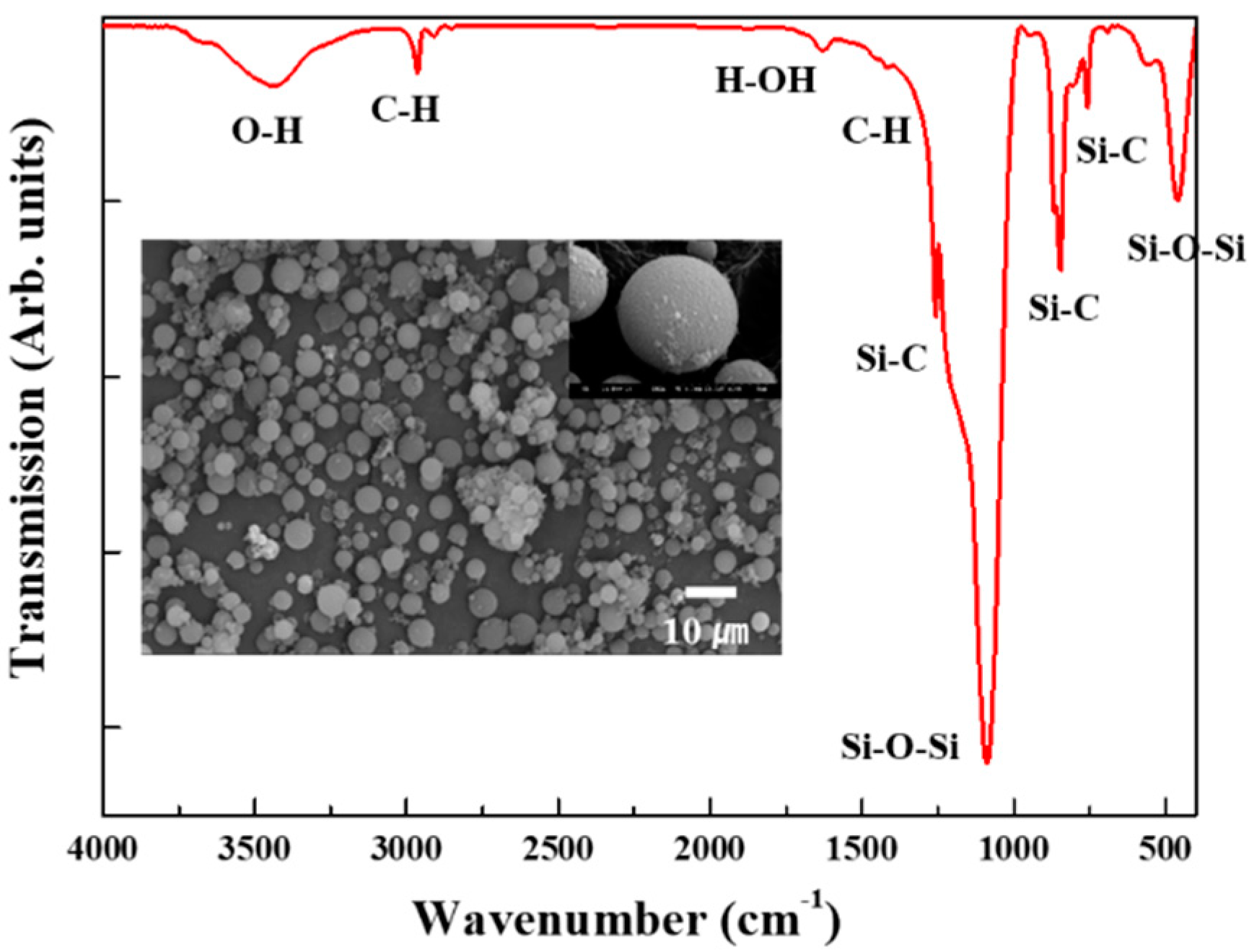


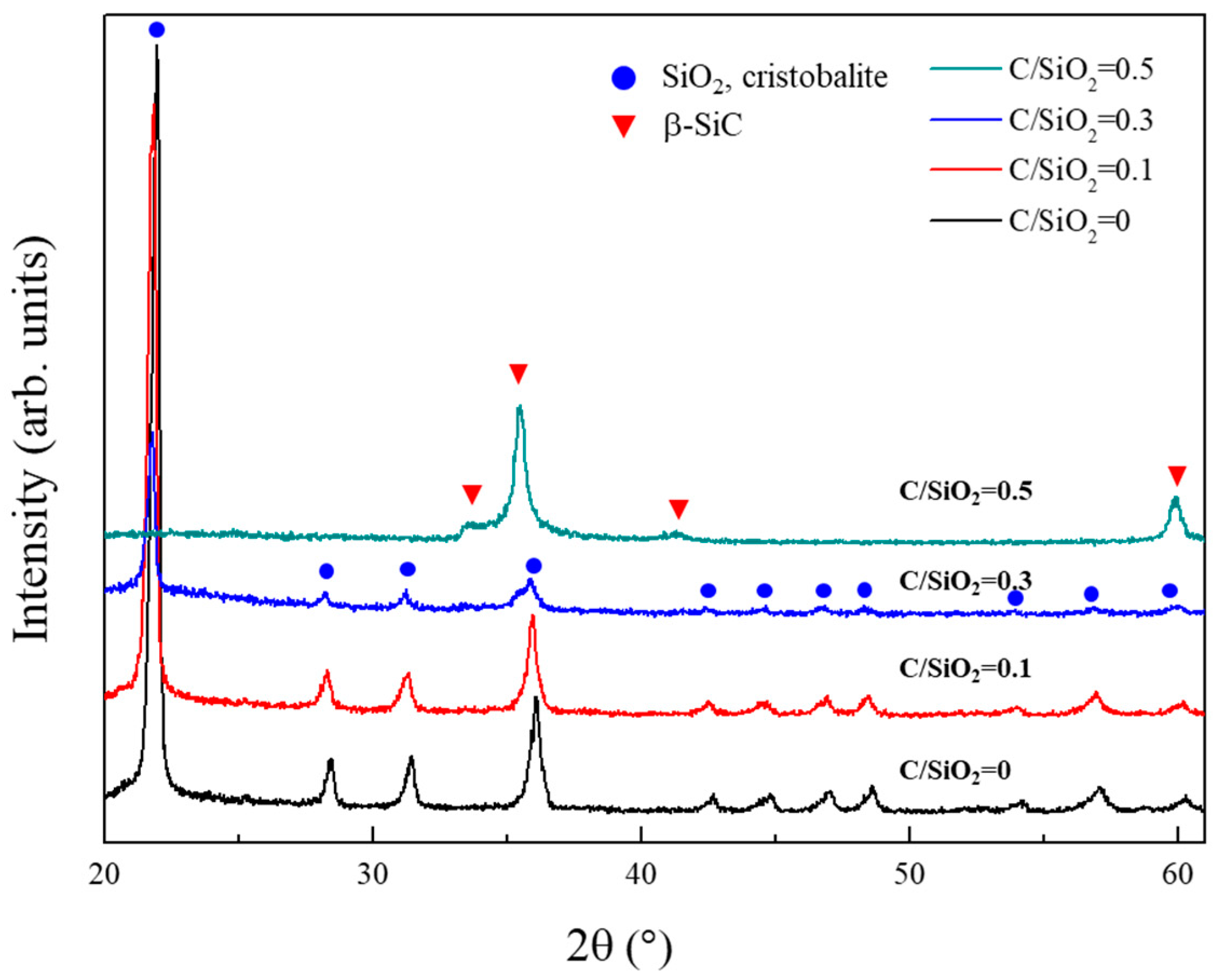
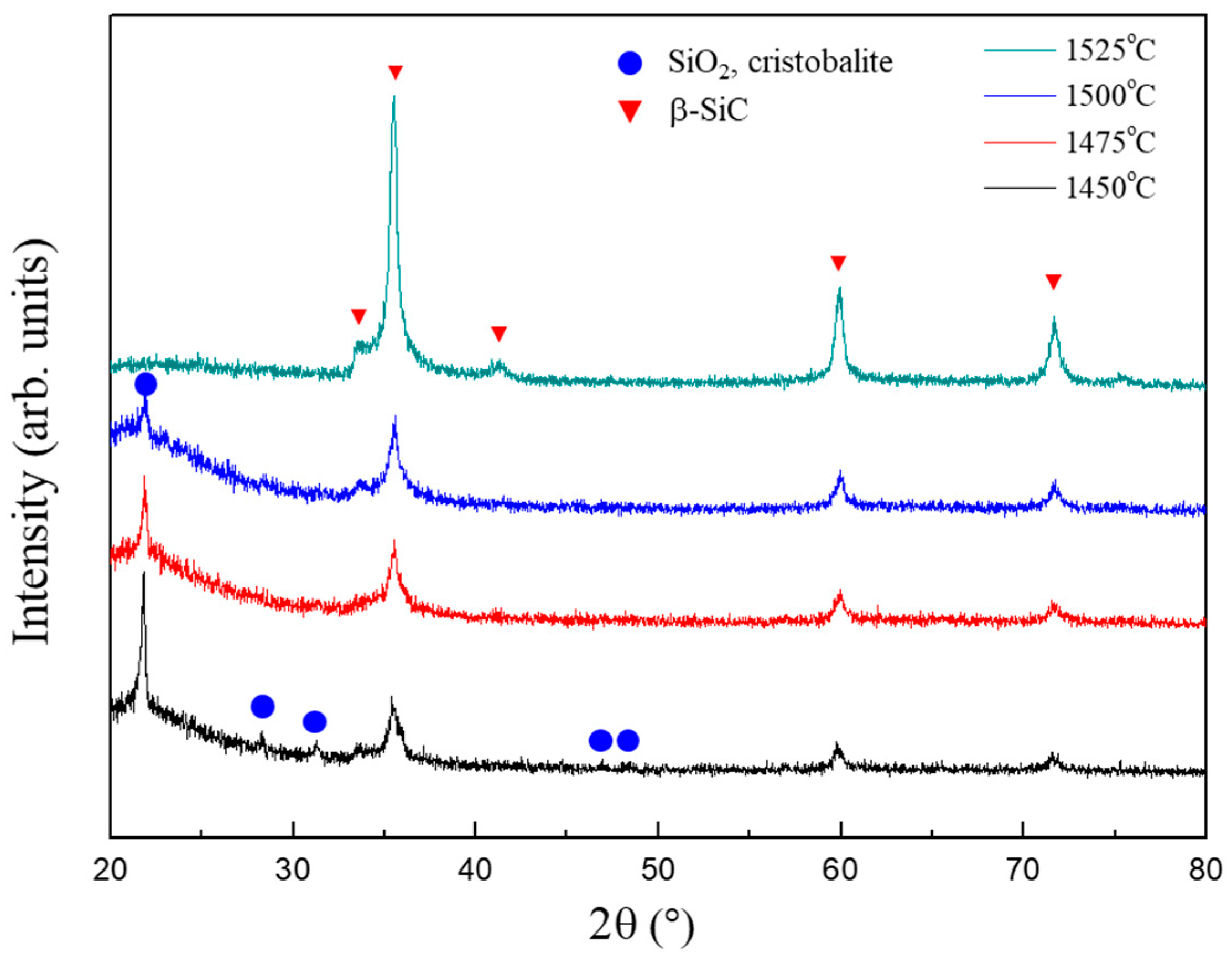
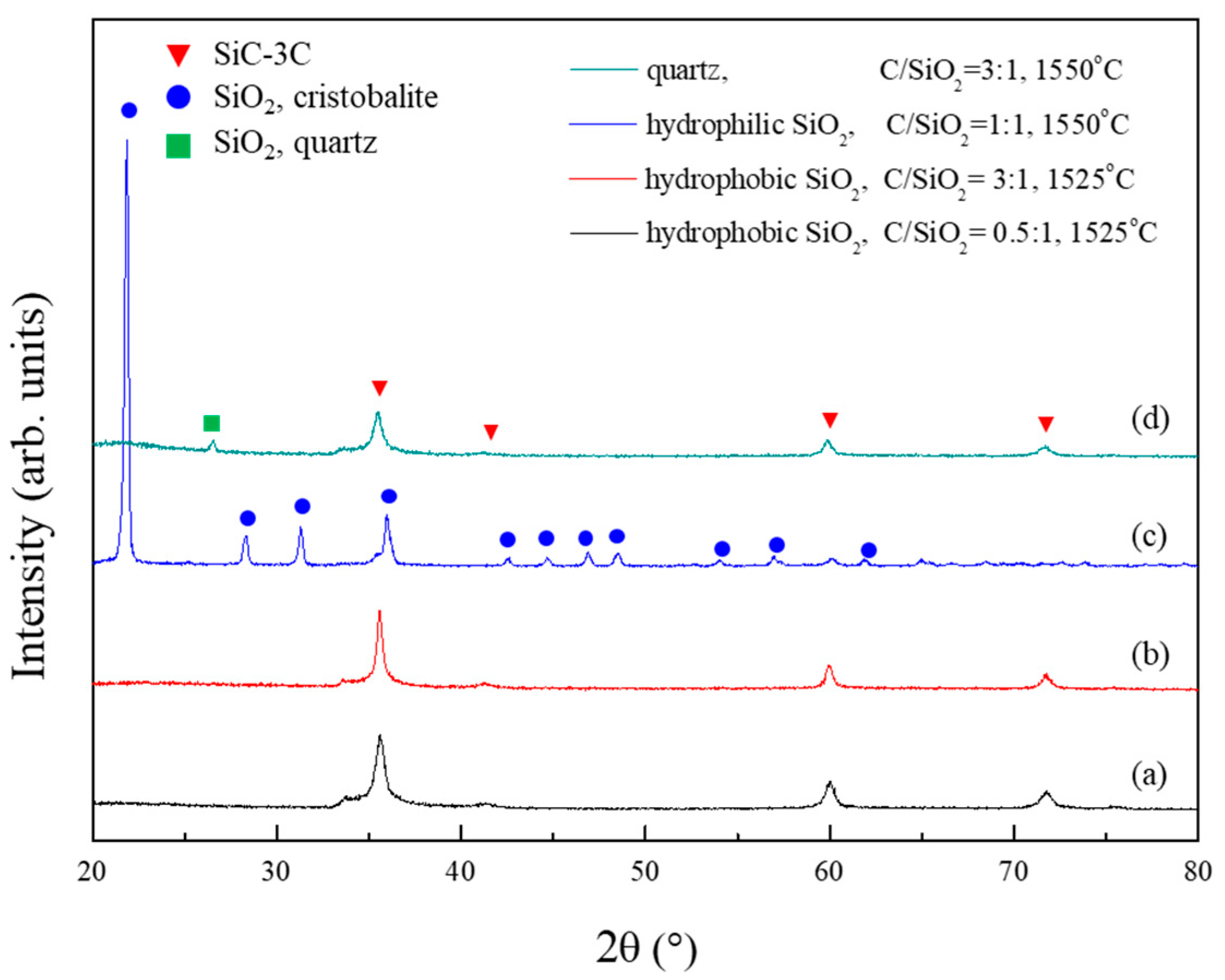

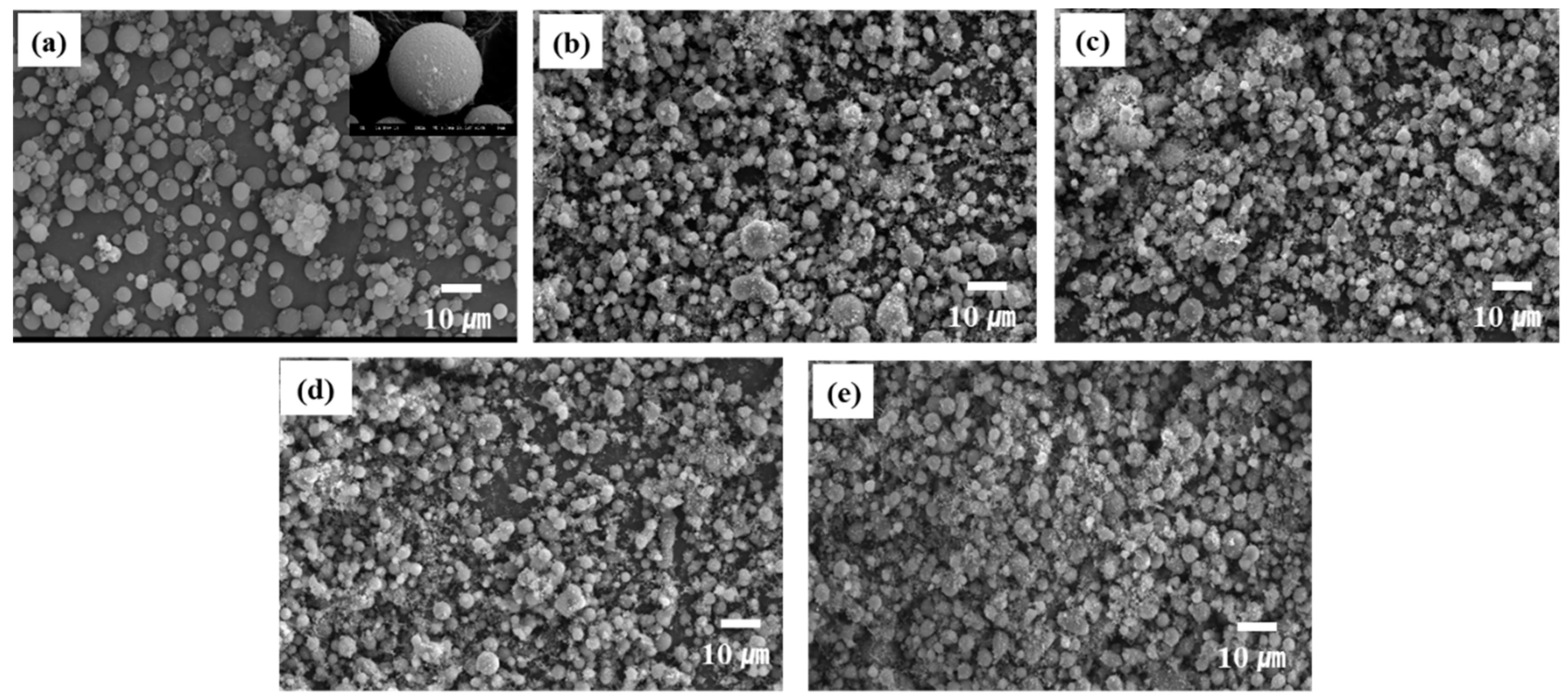
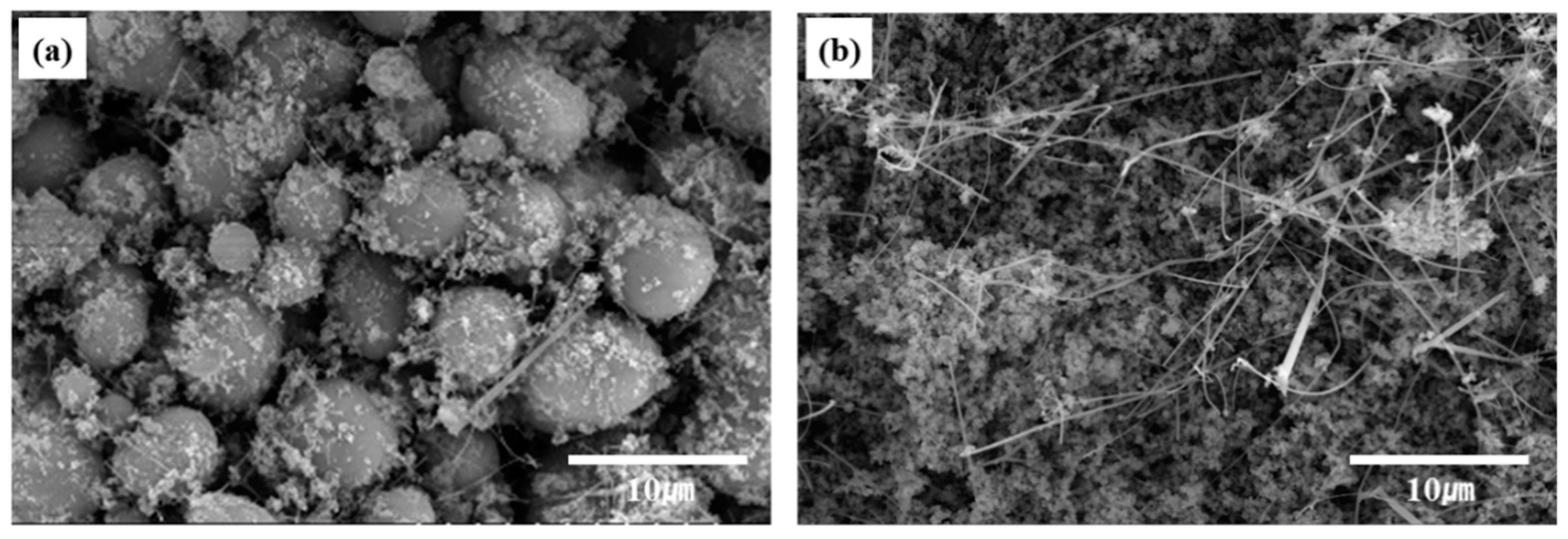
| Tap Density, g·cm−3 | Porosity, % § | BET Surface Area, m2·g−1 | Pore Volume, cm3·g−1 | Pore Diameter, nm | |
|---|---|---|---|---|---|
| Silica aerogel | 0.12 | 94.5 | 730 | 2.35 | 12.89 |
© 2020 by the authors. Licensee MDPI, Basel, Switzerland. This article is an open access article distributed under the terms and conditions of the Creative Commons Attribution (CC BY) license (http://creativecommons.org/licenses/by/4.0/).
Share and Cite
Lee, K.-J.; Kang, Y.; Kim, Y.H.; Baek, S.W.; Hwang, H. Synthesis of Silicon Carbide Powders from Methyl-Modified Silica Aerogels. Appl. Sci. 2020, 10, 6161. https://doi.org/10.3390/app10186161
Lee K-J, Kang Y, Kim YH, Baek SW, Hwang H. Synthesis of Silicon Carbide Powders from Methyl-Modified Silica Aerogels. Applied Sciences. 2020; 10(18):6161. https://doi.org/10.3390/app10186161
Chicago/Turabian StyleLee, Kyoung-Jin, Yanggu Kang, Young Hun Kim, Se Won Baek, and Haejin Hwang. 2020. "Synthesis of Silicon Carbide Powders from Methyl-Modified Silica Aerogels" Applied Sciences 10, no. 18: 6161. https://doi.org/10.3390/app10186161





